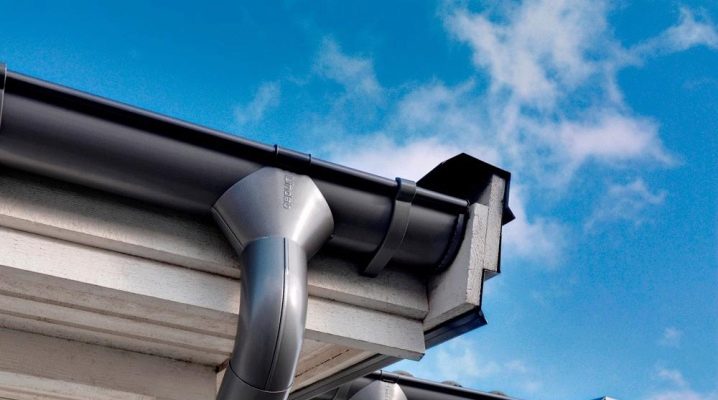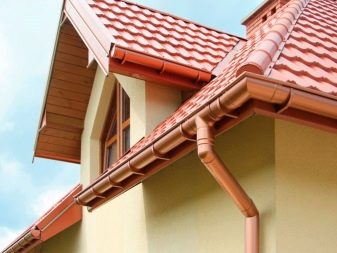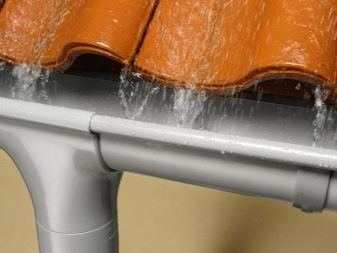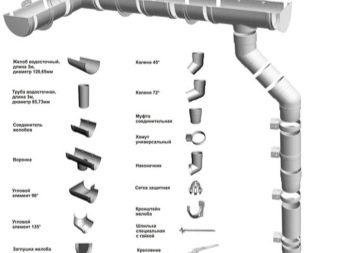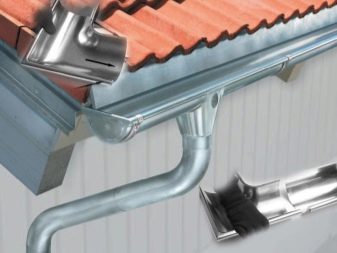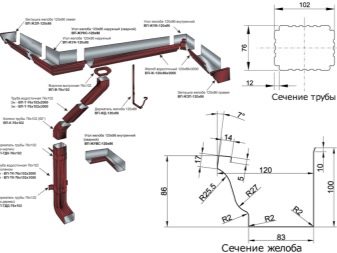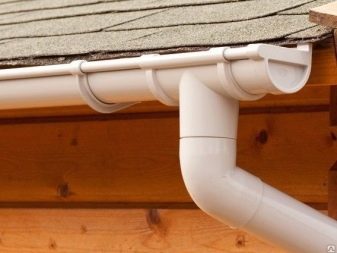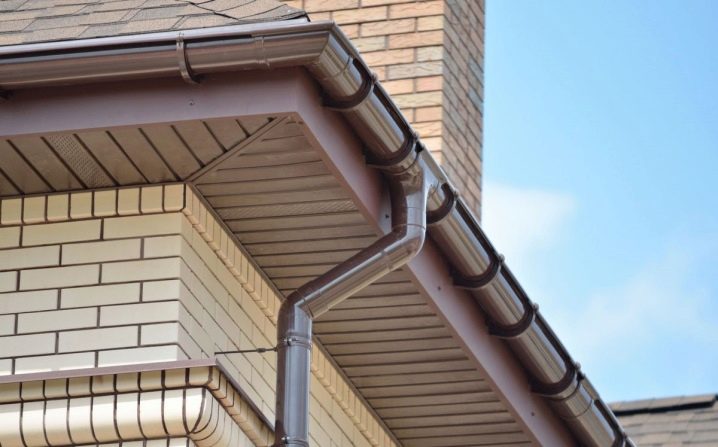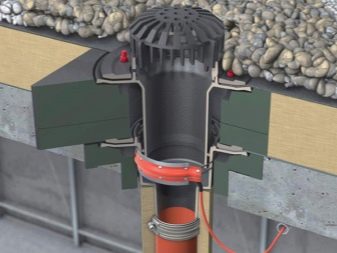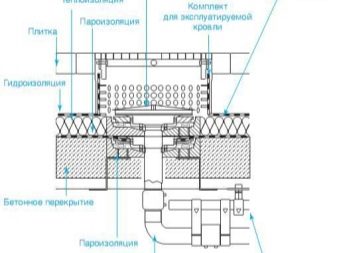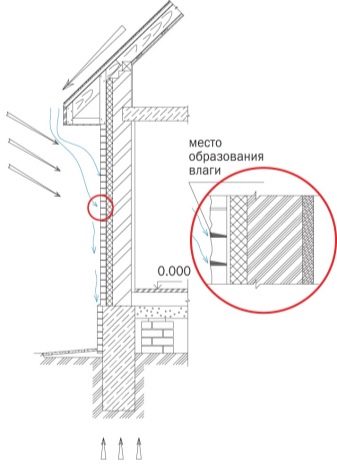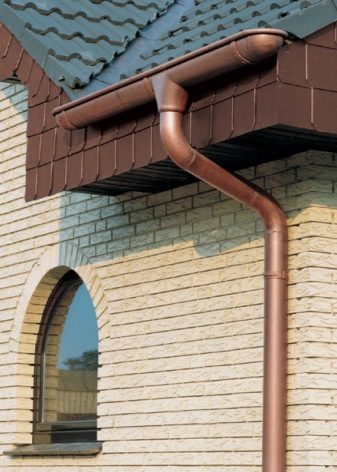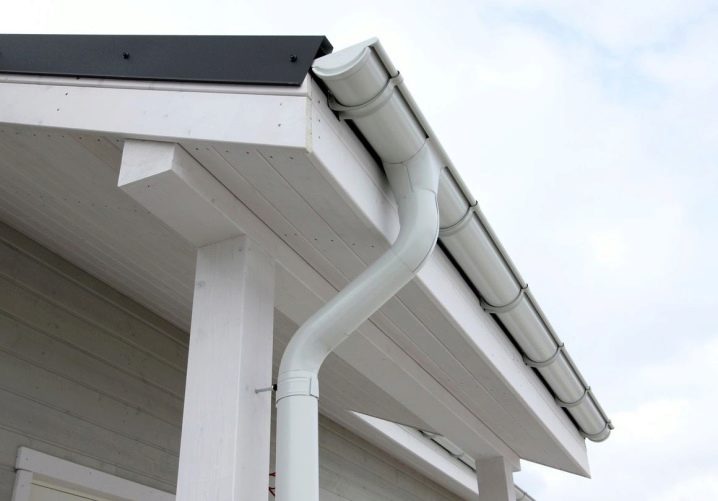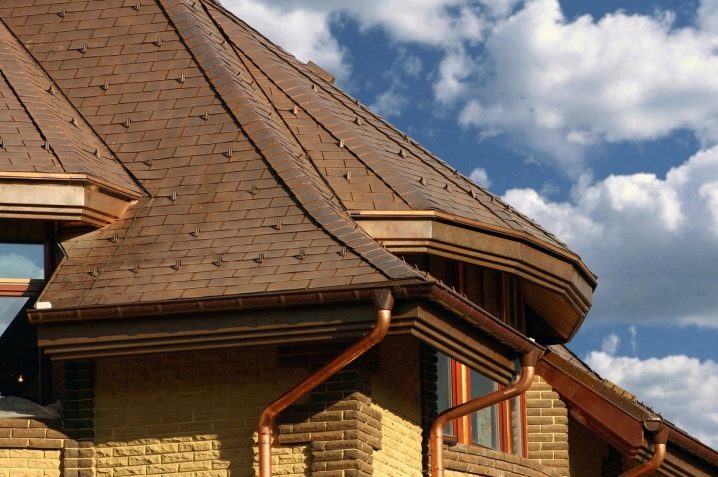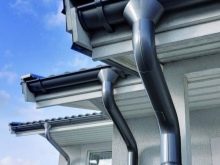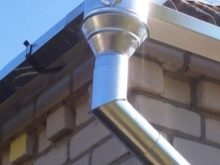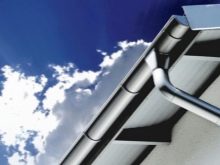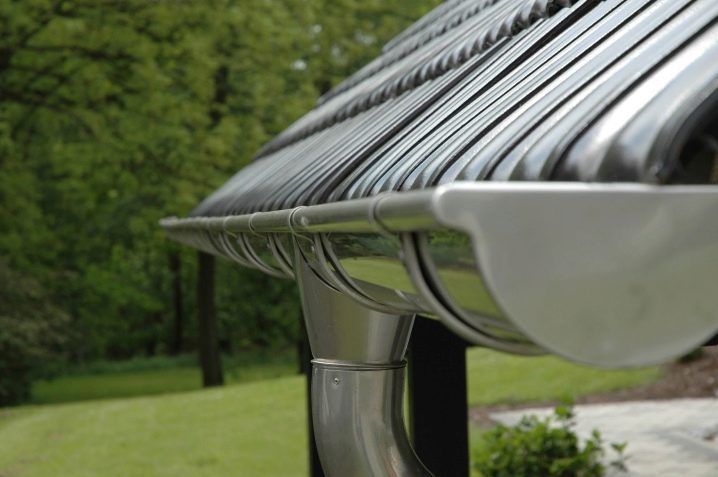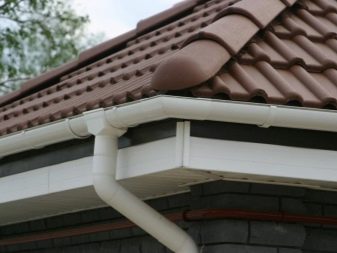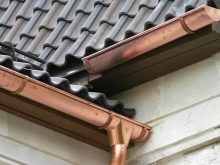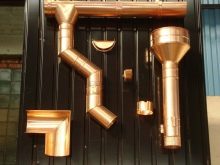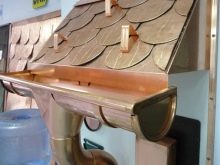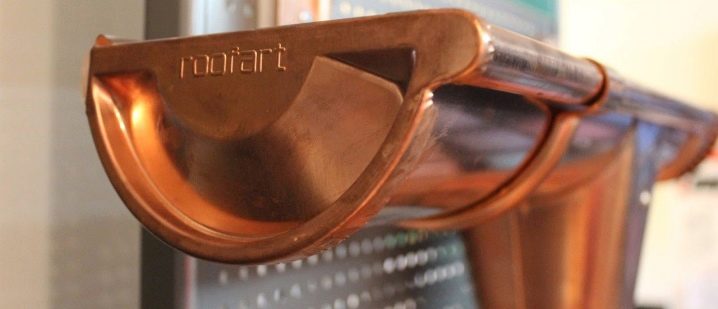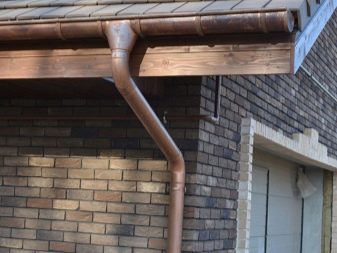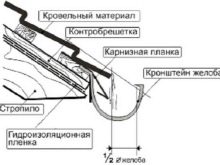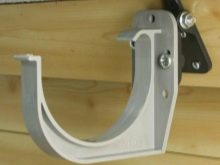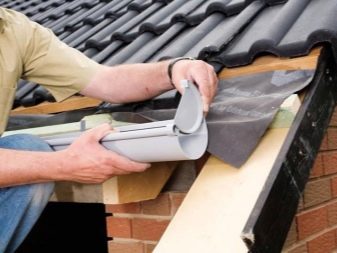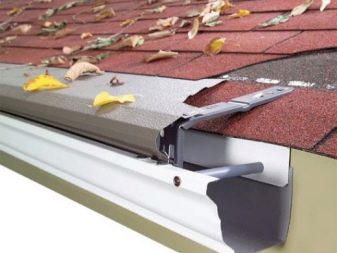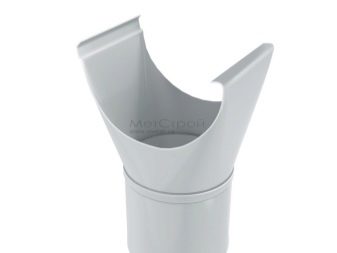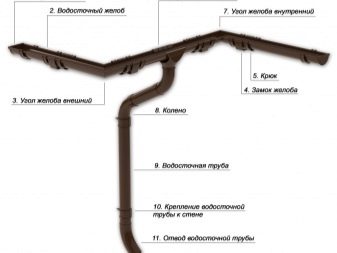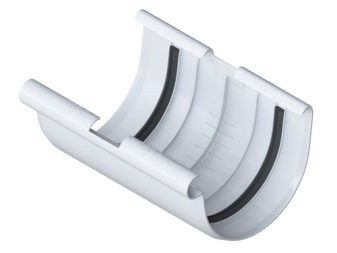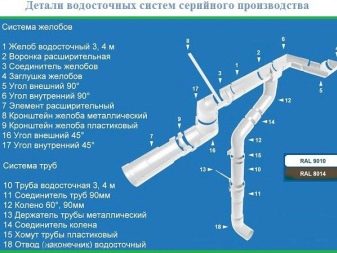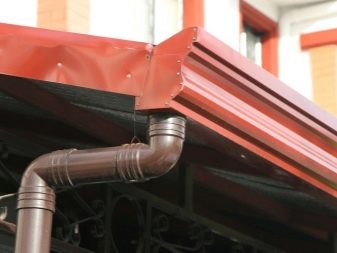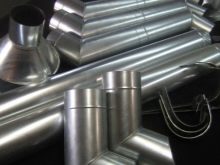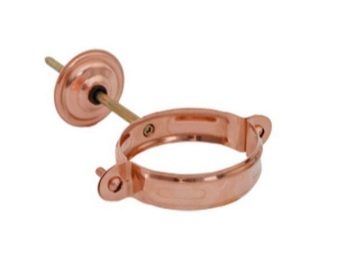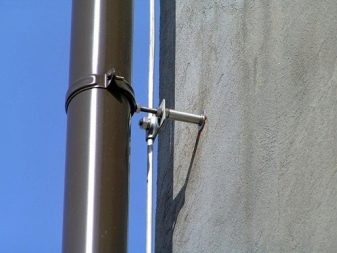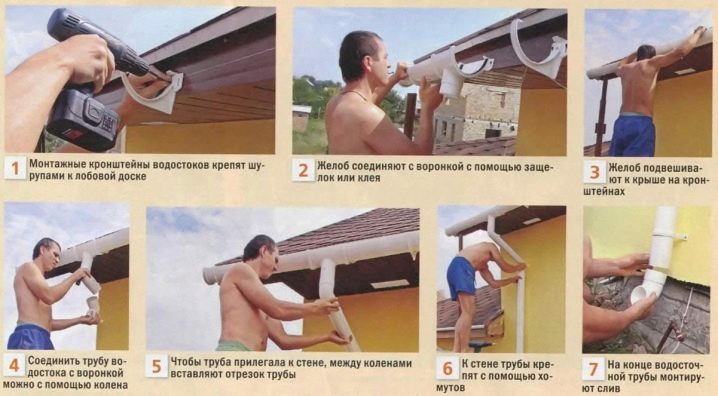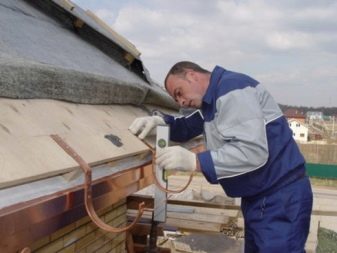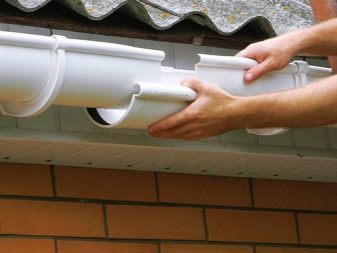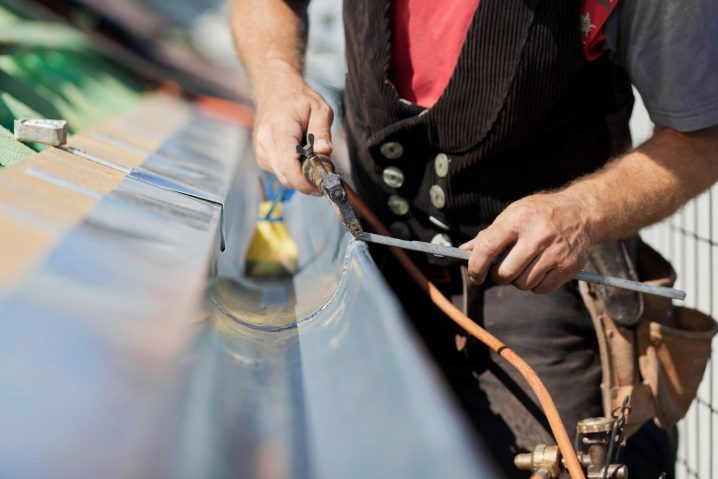How does the drainage system?
Drainage system assigned an important role in the arrangement of a country house. With its help, the roof gets rid of melt and rainwater, which guarantees the protection of walls and foundations from moisture. For a competent choice, you should familiarize yourself with how the drainage system is arranged.
Special features
The drainage system is a component that is aimed at collecting and discharging precipitation and melt water. The system organizes the collection of water on the roof, protecting the foundation and walls from the damaging effects of moisture.
Modern drains can collect and divert rainwater from the roof, which is characterized by complex shapes or structures. Chutes with pipes can have different lengths, diameters, shapes (there are products in the shape of a rectangle, a circle and a trapezium). Such quality allows to equip the drainage system under any roof. In modern gutters there are all the components that are required for quick and high-quality installation.
In addition to providing protection, the drain has an aesthetic component and is able to decorate the facade of the building, highlighting the roof and giving the finished image to the building.
Modern drainage system is aimed at long and flawless operation. In the drain there is a funnel, gutters, drain pipes, which, with proper installation, are responsible for collecting precipitation and their subsequent discharge into the stormwater drainage system. The key task of the drain is the elimination of splashes and the removal of moisture from the foundation of the structure.
There are not only round pipes and gutters, but also products with a rectangular shape. They have not only an unusual design, but also certain features that the round design cannot boast.
Features of rectangular products:
- Neat look. The auxiliary casing is put on the chute, thus hiding the system. The product gives the building the effect of a solid roof.
- Bandwidth. Because of its geometrical features, the square shape is able to miss more water than a round one.
- Resistance to increased loads. Such troughs are able to withstand frozen water, as well as increased rainfall.
- Complicated installation. The installation of such a system is accompanied by additional difficulties, which consist in the use of sealants and rivets.
- Square gutter systems have a higher cost in contrast to round products.
- Drainage systems are considered an indispensable component in regions with high humidity. However, when used in places where it rains less frequently, such systems will be too expensive. The use of drains in this case will be justified only by an attractive and original appearance.
Technical requirements
Installing a drain is not considered a difficult task, but when roofing equipment should take into account the technical requirements that are imposed by the SNiP in relation to the installation.
Drainage should be installed with the following requirements:
- Suspended or wall-mounted gutters can only be installed onroofs, the angle of the slope of which is not less than 15 degrees.
- The minimum value of the longitudinal tray should be 2%.
- For mounting on the roof, gutters with a side height of 120 mm can be used.
- Each element of the system for drainage must comply with GOST 7623-75.
- Between the drain pipes allowed a maximum distance of 24 meters.
- When installing a drainage system for a house, the section of pipes should be calculated on the basis of the following data: no more than a square meter of roof is allocated for 1.5 square centimeters of pipe.
- Similar requirements are imposed for systems that are located in the climate zone with a reduced likelihood of freezing water.
The norms and rules of SNiP inform that in other climatic zones it will be necessary to install internal systems in which water will be drained outside, in order to prevent the formation of ice in the gutters.
Kinds
Based on the method of installation weirs are divided into two types:
- internal;
- outdoor.
Drainage systems of internal type are installed on large structures, and outdoor products qualitatively perform the tasks assigned to private facilities.The choice of the type of drain is influenced by climatic conditions and the material used to equip the roof.
Organized by
Organized drains are a fully thought-out system that acts as a defense against the negative effects of moisture. Such a decision has replaced unorganized structures and is not a separate component from the entire building.
Organized drainage systems are able to perform several functions at once, among which the main one is to protect the fundamental part of the house from moisture. If the building is not provided with a drain, rainwater will immediately flow to the base of the house. For a while, this fact will not cause inconvenience until the concrete is saturated with water. It will become more fragile and ultimately the foundation will not be able to cope with the significant weight of the construction.
Also, drainage systems protect the front part of the house and facing material from water. If you neglect the drain, you will need frequent repair of external walls.
The water drainage system is able to benefit the external facing of the site.Before rainwater soaks into the soil, they will for some time be located on the surface of the site, creating puddles. Water accumulations adversely affect the appearance of the area.
There are modern drains, which are aimed at protecting not only the main part of the house and the site, but also the roof itself. For example, for building objects with a flat roof, internal organized drains are able to perform an aesthetic function. Thanks to modern materials, you can equip a drain that will be perfectly combined with any home.
SNiP divides organized drains into two categories: external and internal. The functionality of both types is identical, but the rest of the products are significantly different.
External
Traditional systems equipped with gutters and pipes on the front of the house are called external organized drains. It is used for arranging buildings with a sloping roof. The key component of such a system is the gutter. The main options are assigned to it. Other details of the drain act as auxiliary elements. After draining all the fluid goes directly into the sewer drainage.
Usually, external drains are attached to the site’s drainage system, which contributes to protection against humidity and groundwater. When equipping an external drainage system You will need a large number of auxiliary parts for pipes: corners, bends, tees.
At installation it is necessary to pay attention to fixing elements. From the reliability and proper installation depends on the life of the entire system.
Internal
Internal organized drainage systems are mounted only on the roof of a flat type. A significant part of the components is located under the facing material, so the design has the same name. Above the roof stand only funnels, which are assigned a function of the collection. In such systems are not present gutters. Pipes are considered the longest detail. Most of the pipes are hidden under the roof cladding, but a number of elements are installed on the front of the house in order to discharge water from the system.
External drains are subject to increased loads. Therefore, to arrange such a system, you should choose only high-quality and durable raw materials.Internal structures provide protection not only to the fundamental part. They eliminate the accumulation of fluid on a flat roof. To do this, at the stage of installation of the facing material in the place where the funnel will be mounted, it will be necessary to make a small recess, which will ensure the natural movement of the fluid.
Unorganized
Unorganized drains are a system in which no drainage funnels, gutters and drain pipes are provided. The precipitation is carried out directly to the ground using the angle of the roof slope.
Undeveloped gutter systems attract many users by the fact that their arrangement will require a minimum cash investment, as well as ease of creation. Water drains independently from the roof, since the structure does not provide for additional details and slopes.
The disadvantages include the following:
- The adverse effect of humidity on the basement of the building. Therefore, experts recommend systematically updating the waterproofing layer.
- Moisture penetrates the structure of the foundation.Because of this, the fundamental foundation begins to collapse. To eliminate deformations, it will be necessary to create a drainage under the ground.
- Unorganized drain has a negative effect on the walls of buildings. Therefore, the construction work will require the creation of an auxiliary waterproofing layer on the walls.
Materials
Production of drainage systems in the domestic market is made of plastic, tin, steel and copper. Gutter drains are not demanded because of their short life and low quality features.
Drainage of galvanized steel with a polymer coating, plastic, copper products, have the same performance and durability. However, each material has its own characteristics, which should be read before buying.
Metallic
Drainage of galvanized steel is characterized by high strength and reliability. They can be mounted on almost any high-rise buildings. The service life of products without an auxiliary protective layer is not more than 10 years.
Steel drains with a polymer coating are distinguished by a long service life (over 50 years).Products for a long time retain the original appearance and have an attractive appearance.
The advantages of metal drain:
- Fixation is made to the roof and the front part with the help of high quality steel fasteners. For this reason, structures are installed on structures of any height and on roofs with a large area.
- Zinc is not characterized by loss of color from exposure to the sun. Polymer surfaces are also resistant to UV rays.
- Drainage systems made of steel are able to function well in different temperatures.
- Colored polymeric coatings act as an auxiliary protective layer against corrosion, and also make products more attractive. With proper selection of color solutions, the chute with pipes can be almost invisible on the front part or, on the contrary, stand out with its original design.
Among the shortcomings are the following:
- Increased noise level during rain, melt waters, as well as wind exposure.
- The considerable weight of metal parts makes the installation process difficult.
- The protective surface may be damaged during the cutting of the gutter and pipes during installation, as well as due to ingress of various debris, pieces of ice. Such damage increases the risk of corrosion.
- The cost of metal drainage systems is higher compared to plastic products.
Plastic
The drain from PVC possesses the long term of operation. Manufacturers give a guarantee for their products for a period of 50 years.
Plastic is not afraid of corrosion and the presence of damage to the outer and inner part of the gutter with pipes, can not lead to a deterioration in functionality. Plastic drains are made from impact-resistant material that is highly resistant to damage. The resulting scratches are almost invisible on the surface of products.
Since plasticity has a high coefficient of thermal expansion, during a temperature differential, parts change their geometrical dimensions. Modern manufacturers take into account these design features and implement drains based on these indicators.
The advantages of plastic drains:
- A wide range of colors.Users are available to purchase drains according to the facing material of the facades.
- PVC drains for a long time retain the original color, which does not fade from the influence of ultraviolet radiation.
- During the production of structures, plasticizers are added, due to which elements gain additional strength.
- Plastic parts are easily cut, which simplifies the installation process.
- The designs have a light weight.
- Drainage systems have a minimal load on the facade of buildings.
- Plastic is not subject to corrosion, it does not form mold or fungus.
- Reduced noise level. Even during heavy rains, the water flows through the pipes silently.
- Affordable price category.
Among the shortcomings, users note the failure of rubber seals, which leads to depressurization of the joints between the parts. However, these defects are easily removed with sealants.
Copper
Copper gutters have been used for several centuries. At the moment, products are also in demand among users. Drains have a solid appearance and luxurious design.After a few years, a noble patina appears on the surface of copper, which also gives drains an attractive appearance.
Copper drainage systems have a long service life, which is more than 150 years. Patina acts as an auxiliary protective layer against environmental influences, therefore other coatings on copper products are not required.
Advantages of copper drainage:
- Copper is considered the best option for the design of unique structures and other author's projects, in which there is a semi-antique styling.
- Copper throughout its service life retains its aesthetic characteristics, despite the change of color after the appearance of the patina layer.
- When soldering a good quality will not require additional sealing joints.
The disadvantages of copper drainage:
- Copper drainage is best suited for roofing of natural tiles, but they are not suitable for installation on the roof of metal-ceramic, sheet materials and soft coatings.
- The installation of such a drain is complicated, therefore these works should be entrusted to specialists.Steel or galvanized fasteners are not allowed for fastening. Between the parts are connected by spikes.
- Copper drains are the heaviest structures that create an increased load on the roof and facade of the structures.
- Copper structures are expensive.
Device
The spillway system consists of several components, each of which has its own role.
Brackets
With the help of these details, the gutter is fixed to the roof. The brackets may differ in their form and material, but the color solution must match the style of the entire system.
Based on the shape of the elements can be mounted in several ways:
- The most common option is fixing the bracket to the frontal roof board. Using this method, the drainage system is easily mounted on the finished roof. As a rule, such parts are present in plastic systems. Due to the vertical ribs, the brackets are resistant to increased loads. For metal structures, short brackets are used, which are mounted in special crutches made of metal.Installation of the gutter is done using studs.
- The second way is to installation of the drain before laying the material for the roof. The gutter is mounted on the rafter foot. Such a solution is important for a roof with a large area on which heavy material is laid. To improve the reliability of fixation, the step between the rafters should not be more than 600 mm.
- Using the following fixation settles a roof in which the distance between the rafters is more than 600 mm. Usually it is metal-tile or ondulin roofs. This method involves the use of different brackets or long hooks, which are fixed on the first batten plank or on the bottom edge of the flooring. Compliance with the rules and procedure for the installation of hooks ensures reliability and long life of the system.
Gutter
Chutes can have different shapes. Products of rectangular, round, semicircular, oval or combined section are made. The chute should have an identical shape with a hook.
Symmetric-shaped gutters belong to the category of universal. Versatility consists in the smooth selection of components.This quality simplifies the design and calculation of the required number of all components for the drainage system.
There are differences in the method of fixation with the brackets. The fastest going system, equipped with the usual snap. It contains swivel latches, with which you can easily dismantle a certain part of the chute for replacement or repair work.
When choosing the gutters, you need to take into account the linear variation of dimensions. To compensate for this quality, special couplings with notches on the inside are on sale. Plastic troughs do not need to be joined to the stop, since such an action can form cracks and breakage.
Metal troughs have less resistance, but when installing it you will need to use a coupling, which will act as a compensator. To provide sufficient protection against icing, you need to warm the gutters or resort to electric heating wires.
Compactors
Seals are made of EPDM rubber. It is a high-quality substitute for rubber mixtures, designed for tight connection of parts.The material is characterized by high elasticity, due to which it restores its original appearance even after prolonged use.
EPDM is resistant to moisture, is not exposed to the influence of the external environment. Usually, the seal is covered with silicone grease, which makes the installation easy, and the product itself is additionally protected from environmental factors.
Drainage funnels
These elements of the drainage system are responsible for collecting the water that flows through the gutters and for the further direction of the liquid in the pipes. In plastic constructions they are a separate part. There are left, right and passing funnels. The first two types have a wall that acts as a plug for the gutter and are mounted at the end. Passage funnel can be located anywhere.
In metal systems, funnels can be installed anywhere. However, for installation, you will need to create a round hole.
Knees
Knee looks like a short curved pipe. They are used as a connecting element between the pipe and funnels, as well as for diverting fluid from the fundamental part of the building.For each pipe, you will need about three bends, two of which will be located at the top and one at the bottom.
Pipes
There are products with a rectangular or round section. It has no effect on the functionality. The choice depends only on the appearance of the facade and the entire drainage system. The length of the pipe can be 1-4 meters. Plastic pipes differ from metal in that they have the same diameter along the entire length. Therefore, for their connection to each other will require a coupling, which indicates additional costs.
Hose clamps
Elements are used to fix the pipes to the front part. They can be made of different materials and have a variety of forms. Plastic clamps have two points of support, metal ones are equipped with one long hardware. Snap-in is made during the grip of the pipe or by screwing.
Installation
Installing the drainage system consists of several stages. Compliance with all rules and requirements allows you to eliminate common mistakes that newcomers often make. First of all it is required to make calculations of the drainage system.This will help the manufacture of a detailed roofing scheme, on which all corners and slope parameters will be present.
Manual installation of drainage do-it-yourself:
- Installation of the drain with your own hands should begin with fixing the funnel in the corners of the building or in the center of the slope. After that, you can begin to install fasteners under the gutter.
- The mount should be installed at a distance that does not exceed two centimeters from the funnel. Clamps will act as holders.
- The liquid should flow freely to the funnels, so the chute should be installed at a small angle to the horizontal. A slope of 3-4 mm should be observed for each meter of the gutter. Tilt check is performed using a construction plumb or level with a nylon thread.
- Based on the placement of the drain funnel, the slope can go from the center to the edge or from one edge to another.
- When all the latches are fixed on the slopes, you can begin to insert gutters. With the help of connectors the elements are docked with each other, with a funnel and angular type adapters.
- Usually there is a rubber seal in the kit with connectors.which does not allow water to seep into the crevices. If the rubber is not included, you will need to purchase it separately and install it in each connector. At a distance of two centimeters from the connector will require the installation of latches.
- If the length of the gutter exceeds the desired value, you will need to cut the part with the help of the leg on the metal. This tool is used to work with any systems, even if plastic parts are used.
- The cut should be treated with sandpaper. There should not be any sticking pieces of material on the surface. After processing, the chute should be installed in the mount.
- Then you need to start installing the drainpipe. Initially, special clamps are attached to the surface of the walls. The spacing of the clamps should be one meter. After fixing it is necessary to insert the pipe into them.
- In the case when the edge of the roof is located at a large distance from the walls, you will need to use a universal knee.
- The knees make it possible to move the pipe to the wall and fix it qualitatively. An ebb is installed at the bottom of the pipe, which must be directed from the walls to allow water to flow into the drainage system, a well. This will require an equipped shower.
- Such a scheme is suitable for the installation of drainage systems of plastic and metal.
- If trees grow near the house, in the fall the gutters can become littered with foliage. If the leaves are not removed in a timely manner, during the first frost a dense lump is formed, which will not allow water to drain from the roof. To avoid such a situation, it will be necessary to install special lath catchers.
When purchasing a drainpipe system and installing it, all nuances should be taken into account (angle of inclination and diameter of the gutters, distance between fasteners). Otherwise, the drainage system may break or not to cope with the tasks.
Tips
To extend the life of drainage systems, experts recommend that you familiarize yourself with the most common mistakes that occur during the purchase and installation of structures. It is better to get acquainted with the errors in advance in order not to make them later.
For some reason the drain can fail:
- The wrong choice of drainage reduces throughput, which can lead to liquid overflow from their gutters.
- Saving on details. The lack of lath catchers can lead to the fact that the drainage will become clogged with fallen leaves and will cease to function.
- The angle of inclination of the gutters is not maintained.In this case, the water will flow out of the gutter.
- Not enough drainpipes. Such an omission will also lead to the fact that water will overflow.
- Increased distance between the brackets. Because of this, the gutter will begin to sag under a significant mass of snow mass and water.
- Exceeding the distance between the clamps for fixation will lead to the fact that they can not cope with wind load. For the same reason, it is not allowed to install the pipe at the corner of the building.
- If the pipe is adjacent to the house, the walls, foundation and basement will be constantly wet, which will lead to destruction.
These errors can lead to the flooding of the fundamental basis of the house, which further provokes the destruction of the building.
To learn how to make a gutter system do it yourself, see the video below.
